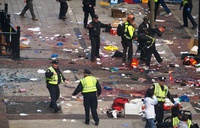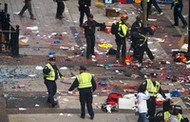Lessons That Could Save Your Life in a Terror Event
Posted by Joseph Alton MD on 19th Sep 2016

Lessons That Could Save Your Life in a Terror Event
written by Joseph Alton, MD of https://www.doomandbloom.net/
I’ve written quite a bit lately about shooting and terror events, but recent events highlight the fact that gun violence isn’t the only way that a terrorist can fulfill their mission of making casualties out of decent citizens. Clearly, bombings, stabbings, or shootings can occur literally anytime and anywhere in the U.S.: at churches, clubs, holiday parties, schools, the mall, at 2 in the morning or in the middle of the day. They’re part of what I call the “New Normal” and we have to be prepared to act if we’re caught in one of these events.
Although I write mostly about disaster medical preparedness, a terror event is a different kind of disaster. It’s one where you can prevent becoming a casualty if you simply know what to do when danger presents itself.Indeed, if you don’t train yourself to anticipate these events, it could be hazardous to your health and that of your family.
I’ve mentioned the concept of “situational awareness” as a way to decrease your chances of becoming a victim in future terror attacks. In these days of Pokemon Go and other smartphone distractions, you’re seeing more and more people not paying attention to their surroundings. In the past, this might get you a bump on the head for walking into a lamp post. In today’s world, however, it could cost you your life.
Situational awareness involves understanding what’s going on in your immediate vicinity that might be represent a threat to your well-being. I don’t mean second-hand smoke here; I’m talking about knowing what immediate dangers may exist that you can avoid or abolish with your actions. Especially important for soldiers in a combat zone, it’s now become just as important for the average citizen in any public space.
In an area at risk (anyplace where multitudes of people gather), simple things might save your life. Things like not having your hoodie up, which can be like blinders on a horse. Things like making a mental note of the nearest exit at the mall. Things like looking around for people who are acting strangely or, perhaps, dressed too warmly for the weather. Someone who might be paying too much attention to an everyday object, such as a trash can (which might contain a bomb).
Behaviors normal in some settings might be an “anomaly” in others: Hopping up and down and screaming may be normal behavior at a rock concert, but not at the local mall. By looking for anomalies in what should be normal behavior in a situation, the situationally aware person will have the best chance to plan an escape when an attack occurs.
To do this effectively, you should always be in a state of what I call “Yellow Alert”. You’re calm and relaxed, but taking in your surroundings: Always observing how people behave, where the nearest exits are, and formulating a plan of action if you’re in a crowd or other at-risk scenario.
In the case of the terrorist who stabbed nine people in Minnesota, it’s likely that he was in a state of agitation, his hands constantly touching the pocket where he kept his weapon. These are anomalies; things you should watch for whenever you’re in a public place.
In a crowd, it would pay to be at the fringes and not in the middle. Having a wall to your back would eliminate a danger that might come at you from behind. Indoors, for example, in a movie theatre, you want a view of the exits as well as the screen. If someone is behaving strangely, move away from them. If someone is screaming at the employee at the local burger joint (I said NO CHEESE!), maybe you should leave and order a pizza instead.
Air Force Colonel John Boyd devised a situational awareness strategy, called the “OODA Loop”, originally meant for aerial combat. It has practical applications, however, for everyday life. The components of the OODA Loop as it pertains to terror events are:
Observe: Stay at Yellow Alert whenever you’re in a public place where groups of people gather.
Orient: Identify behaviors that are not appropriate for the situation. These anomalies will tell you who and what to keep an eye on.
Decide: Determine the best course of action that will allow your escape or might eliminate the danger altogether.
Act:Initiate the plan of action and commit to those actions.
It’s difficult to instill a culture of situational awareness in a population, but doing so would save lives. Teaching your kids the basics can help keep them safe, especially if you start early. When you’re out with the kids, tell them to pay attention to what’s going on where you are. Once the family has left the area, ask them how many people were there, what they were wearing, or other details. Ask them what they would have done if something happened. Do this often enough, and it will, hopefully, become common practice. They’ll learn to pay less attention to their smartphones and more to their surroundings.
It would also benefit society if the next generation is taught what to do to help those wounded in a terror attack. In this scenario, law enforcement must pass the wounded by until the terrorist is neutralized. It may surprise you to know this, but there’s someone out there making more casualties, and the police, first and foremost, must abolish the threat. Yet, it’s thought that 1 in 5 deaths from hemorrhage might be avoided with the quick action of bystanders.
It may be time to add a fourth “R” to education. In addition to Reading, (w)Riting, and (a)Rithmatic, Reducing hemorrhage might be a useful thing for kids to learn once they reach a certain age. Indeed, I predict that there will come a time when first aid kits will occupy a space on the walls next to the fire extinguishers and automated defibrillators in schools and other public places.
All this attention to detail may seem paranoid to you, but it’s time to realize that these are dangerous times. Incorporate situational awareness into a calm, observant mindset and you’ll gain those extra seconds that could mean the difference between life and death in troubled times.

